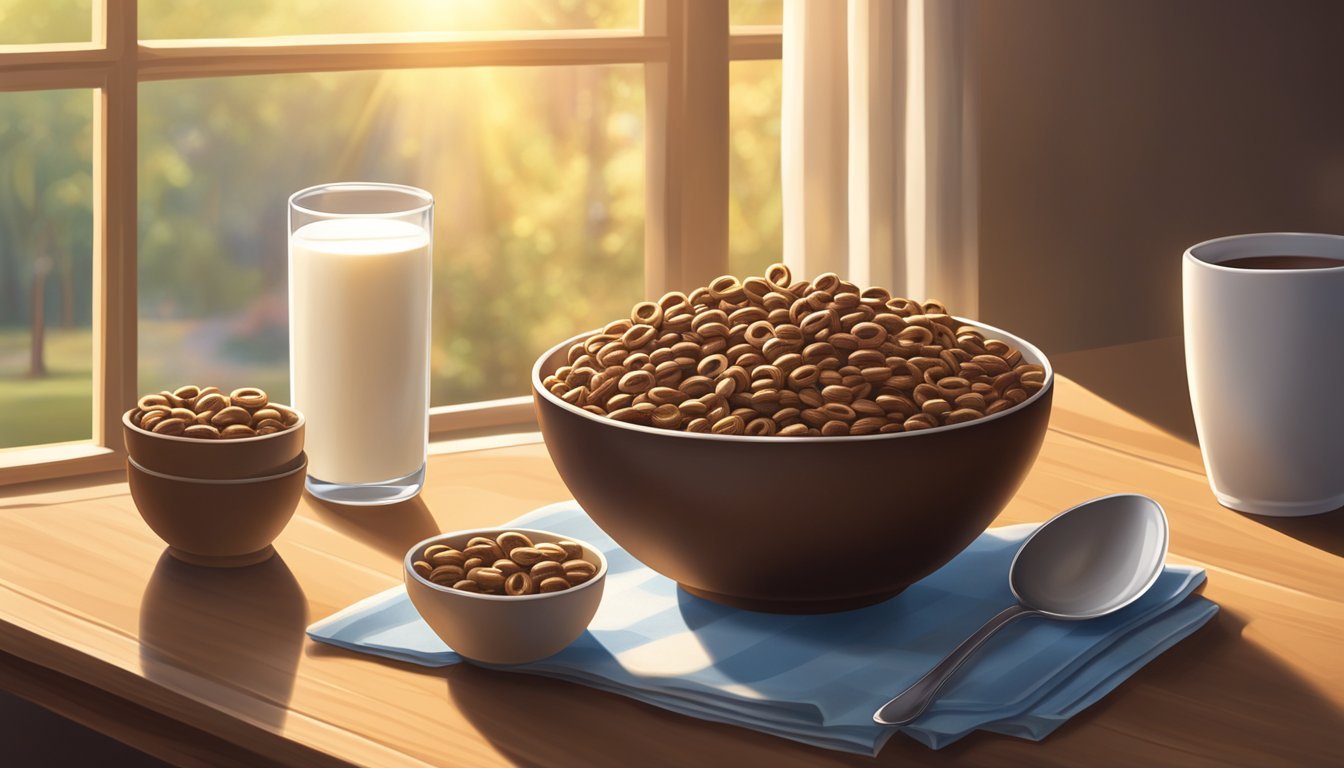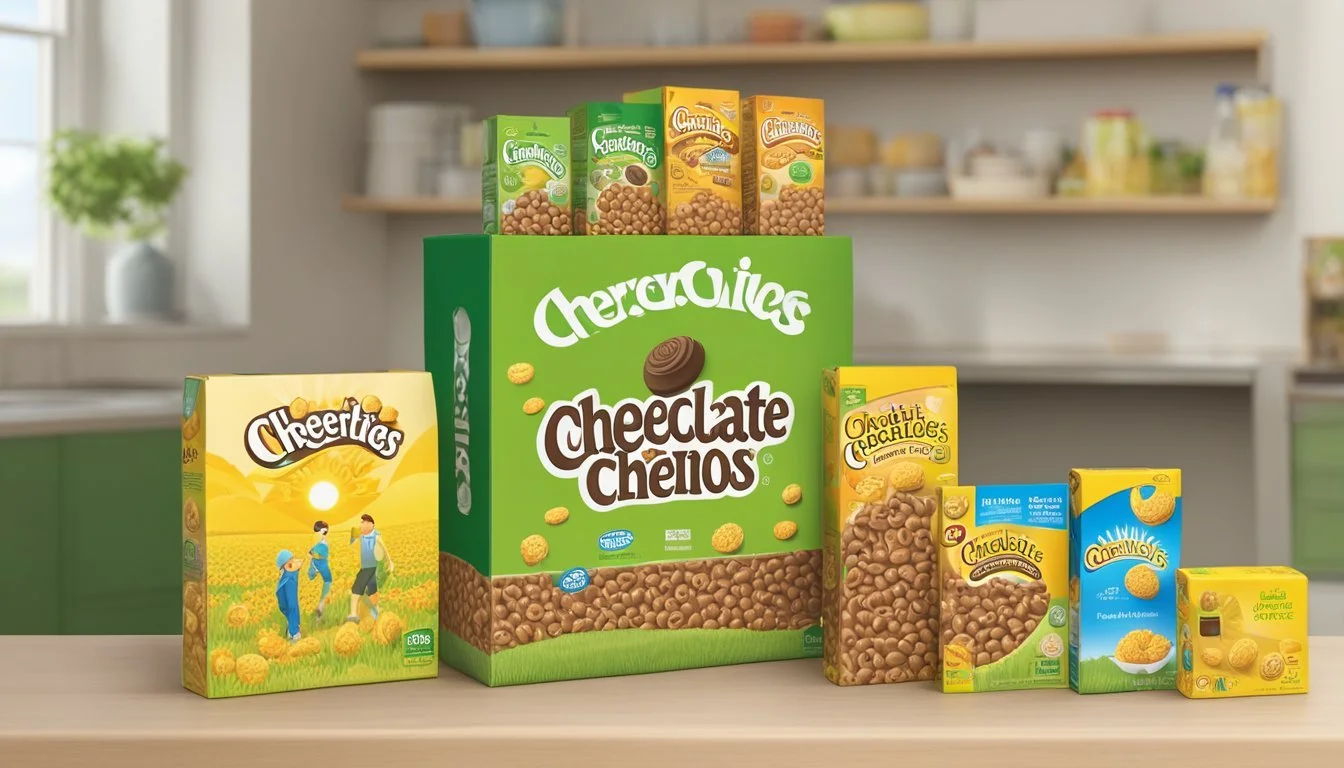Chocolate Cheerios Nutrition Facts & More
A Balanced Breakfast Option
Chocolate Cheerios offer a tasty twist on the classic breakfast cereal. Made by General Mills, these whole grain oat rings combine the familiar Cheerios shape with real cocoa for a chocolatey flavor. One cup (36g) of Chocolate Cheerios contains 140 calories, with 12% from fat, 79% from carbohydrates, and 8% from protein.
The cereal provides a balance of nutrients to start the day. It contains whole grain oats as the first ingredient, offering fiber and essential vitamins. The addition of cocoa gives it a rich chocolate taste without excessive sugar or calories. Chocolate Cheerios can be enjoyed with milk, as a dry snack, or incorporated into recipes for a chocolatey crunch.
General Mills promotes Chocolate Cheerios as part of a heart-healthy diet. The cereal is gluten-free and may help lower cholesterol when consumed regularly as part of a balanced eating plan. This makes it an option for those seeking a breakfast that satisfies chocolate cravings while providing nutritional benefits.
Nutritional Profile
Chocolate Cheerios offer a mix of macronutrients, vitamins, and minerals. This cereal provides energy from carbohydrates and contains added sugars, while also offering some dietary fiber.
Macronutrients
A 1-cup (36g) serving of Chocolate Cheerios contains 140 calories. The macronutrient breakdown is as follows:
Total Carbohydrates: 29g (79% of calories)
Protein: 3g (8% of calories)
Total Fat: 2g (12% of calories)
The fat content includes minimal saturated fat and no trans fat. Cholesterol content is 0mg per serving.
Vitamins and Minerals
Chocolate Cheerios are fortified with several vitamins and minerals:
Calcium: 10% Daily Value (DV)
Iron: 45% DV
Vitamin A: 10% DV
Vitamin C: 25% DV
Other nutrients include:
Zinc
Vitamin D
B vitamins (Thiamin, Riboflavin, Niacin, Vitamin B6, Folic Acid, Vitamin B12)
These additions contribute to the cereal's nutritional value.
Sugars and Sweeteners
Sugar is the second ingredient listed for Chocolate Cheerios, indicating a significant presence. The cereal contains:
Total Sugars: 9g per serving
Added Sugars: 9g (18% DV)
Sweeteners used include:
Sugar
Corn syrup
Barley malt extract
These ingredients contribute to the cereal's sweet chocolate flavor.
Dietary Fiber Content
Chocolate Cheerios provide dietary fiber, an important component for digestive health:
Dietary Fiber: 3g per serving (11% DV)
The fiber comes from whole grain oats and oat bran, which are key ingredients in the cereal. This fiber content may contribute to feelings of fullness and support digestive function.
Serving Size and Servings Per Container
The standard serving size for Chocolate Cheerios is 1 cup (27 grams). This portion provides a convenient way to measure and compare nutritional information.
General Mills packages Chocolate Cheerios in various box sizes. A typical large size box contains approximately 11 servings of the cereal.
The Nutrition Facts label on Chocolate Cheerios boxes displays information based on this 1-cup serving. It includes details such as calories, fat content, carbohydrates, and protein.
Daily Values on the label are calculated using the 27-gram serving size. These percentages help consumers understand how the cereal fits into their daily nutritional needs.
For those tracking their intake, it's important to note that consuming more or less than the listed serving size will affect the nutritional values proportionally.
Health Benefits and Considerations
Chocolate Cheerios offer a mix of nutritional benefits and potential drawbacks. Their whole grain content provides fiber, while added vitamins and minerals contribute to overall health. However, sugar content and portion control are important factors to consider.
Role in Balanced Diet
Chocolate Cheerios contain whole grain oats, providing dietary fiber essential for digestive health. A serving offers about 3 grams of fiber, contributing to the recommended daily intake. The cereal is fortified with vitamins and minerals, including iron, zinc, and B vitamins.
Real cocoa in Chocolate Cheerios adds antioxidants, which may have health benefits. However, the sugar content is higher than plain Cheerios, at around 9 grams per serving. This should be factored into daily sugar intake limits.
Portion control is crucial. The recommended serving size is 1 cup, which helps manage calorie and nutrient intake effectively.
Impact on Health Conditions
Chocolate Cheerios may affect certain health conditions differently. The whole grain content can support heart health by helping to lower cholesterol levels. Studies suggest that regular consumption of whole grains is associated with reduced risk of cardiovascular disease.
For individuals with diabetes, the glycemic impact should be considered. While lower than some sugary cereals, Chocolate Cheerios still contain added sugars that can affect blood glucose levels.
The fortified calcium and vitamin D in Chocolate Cheerios support bone health. This is particularly beneficial for growing children and adults at risk of osteoporosis.
Suitability for Dietary Restrictions
Chocolate Cheerios are gluten-free, making them suitable for individuals with celiac disease or gluten sensitivity. They're also low in sodium, containing about 140 mg per serving. This makes them a good choice for those monitoring sodium intake.
The cereal is dairy-free, suitable for lactose-intolerant individuals or those following a vegan diet. However, it's not considered a protein-rich food, with only 2 grams per serving.
For those with nut allergies, it's important to check the label, as Chocolate Cheerios are produced in facilities that also process nuts. Individuals with specific dietary concerns should consult the full ingredient list before consumption.
Comparison With Other Cereals
Chocolate Cheerios' nutritional profile differs from other cereals in several key areas. The comparisons below examine how it stacks up against related products.
Cereals Within the Chocolate Cheerios Line
Chocolate Cheerios contains more sugar than original Cheerios but less than some other flavored varieties. It has 9 grams of sugar per serving compared to 1 gram in original Cheerios.
The chocolate variety provides 2 grams of fiber per serving, which is similar to other Cheerios flavors. Protein content remains consistent at 2-3 grams across most Cheerios varieties.
Chocolate Cheerios has slightly more calories at 120 per serving versus 100 in original Cheerios. Fat content is also marginally higher at 2 grams compared to 1.5 grams.
Similar Chocolate Flavored Cereals
Compared to other chocolate cereals, Chocolate Cheerios tends to have moderate sugar content. It contains less sugar than cereals like Cocoa Puffs (12g) but more than Kashi Cocoa Crisp (6g).
Fiber content in Chocolate Cheerios (2g) is lower than some competitors. Kashi Cocoa Crisp offers 4 grams of fiber per serving.
Protein levels are comparable to many chocolate cereals, typically ranging from 2-3 grams per serving. Some protein-fortified options may offer higher amounts.
General Mills Brand Comparison
Within the General Mills portfolio, Chocolate Cheerios falls mid-range for sugar content. It has more sugar than Fiber One (0g) but less than sugary options like Lucky Charms (12g).
Whole grain oats remain the first ingredient in Chocolate Cheerios, consistent with other Cheerios varieties. This contributes to its fiber and nutrient content.
Vitamin and mineral fortification is similar across many General Mills cereals. Chocolate Cheerios provides 10% daily value of several B vitamins and iron per serving.
Ingredients and Additives
Chocolate Cheerios contain a mix of whole grains, sweeteners, flavorings, and additives. The cereal aims to balance nutritional value with appealing taste and texture.
Cocoa and Flavorings
Cocoa processed with alkali gives Chocolate Cheerios their signature flavor. This ingredient provides the chocolatey taste without using milk chocolate. Unsweetened chocolate is also included to enhance the cocoa notes.
Natural flavors are added to further refine the cereal's taste profile. These may include vanilla or other complementary flavors that pair well with chocolate.
The combination of cocoa and natural flavorings creates a balanced chocolate taste that appeals to both children and adults.
Preservatives and Colorings
Vitamin E (mixed tocopherols) serves as a natural preservative in Chocolate Cheerios. This antioxidant helps maintain freshness and extends shelf life.
Caramel color is used to enhance the cereal's appearance, giving it a deeper brown hue that matches its chocolate flavor. This coloring agent is commonly used in many food products.
Tripotassium phosphate, while primarily a mineral supplement, can also act as a preservative and pH regulator in cereals.
Whole Grains and Oat Content
Whole grain oats form the primary ingredient in Chocolate Cheerios, providing fiber and essential nutrients. Oat bran is also included, boosting the cereal's fiber content.
Corn starch and corn syrup are used in the cereal's formulation. These ingredients help with texture and sweetness, respectively.
Canola oil or sunflower oil may be used in small amounts to enhance the cereal's crunch and prevent sticking during processing.
Salt is added in moderation to balance flavors and enhance the overall taste profile of the cereal.
Packaging and Sustainability
General Mills, the maker of Chocolate Cheerios, has taken steps to reduce packaging across its cereal brands. In 2021, the company implemented changes that saved approximately 618 tonnes of plastic and cardboard packaging for several of its core brands.
The Cheerios 2 Box is an example of innovative packaging technology. This proprietary design allows cereal to be packed more densely, reducing paperboard usage by 200,000 pounds annually.
Sustainability efforts extend beyond just reducing materials. Many Cheerios boxes feature the Box Tops for Education program, which supports schools while encouraging recycling.
The environmental impact of cereal packaging remains a concern. While reductions have been made, there is still room for improvement in materials used and overall waste generation.
Cereal companies continue to explore eco-friendly packaging options. These include using recycled materials, designing for easier recyclability, and reducing overall package sizes without compromising product integrity.
Consumers can contribute to sustainability efforts by properly recycling cereal boxes and plastic liners where facilities exist. Some areas may also have composting options for certain packaging components.
Allergen and Safety Information
Chocolate Cheerios contain whole grain oats as the primary ingredient. For those with celiac disease or gluten sensitivity, it's important to note that this cereal is labeled as gluten-free.
The product does not contain any of the top 8 most common allergens like peanuts, tree nuts, milk, eggs, fish, shellfish, soy, or wheat. However, individuals with severe allergies should always check the packaging for the most up-to-date information.
General Mills, the manufacturer of Chocolate Cheerios, processes this cereal in facilities that handle other ingredients. As a precautionary measure, the packaging may include statements about potential cross-contamination risks.
Key allergen information for Chocolate Cheerios:
Gluten-free
No peanuts or tree nuts
Dairy-free
Egg-free
Soy-free
Consumers with specific dietary needs or allergies should consult the product label or contact General Mills directly for the most current and accurate allergen information.
Consumer Tips
Chocolate Cheerios offer a tasty breakfast option with some nutritional benefits. Proper storage and creative serving ideas can enhance your experience with this cereal.
Storage and Shelf Life
Store Chocolate Cheerios in a cool, dry place to maintain freshness. Keep the bag tightly sealed after opening to prevent moisture and air exposure. The cereal typically has a shelf life of 6-8 months when stored properly.
Check the "best by" date on the package for guidance. Stale Cheerios may lose their crunch but are generally safe to eat if stored correctly. Discard the cereal if you notice any signs of mold or unusual odors.
Consider transferring the cereal to an airtight container for longer-term storage. This can help preserve freshness and prevent pantry pests.
Creative Serving Suggestions
Chocolate Cheerios can be enjoyed beyond the breakfast bowl. Use them as a topping for yogurt parfaits or ice cream for added crunch and flavor. Mix Chocolate Cheerios with nuts and dried fruit to create a kid-friendly trail mix.
Add the cereal to homemade granola bars or energy balls for a chocolatey twist. Crush Chocolate Cheerios and use as a coating for banana pops or as a crust for no-bake cheesecake.
For a decadent treat, melt unsweetened chocolate and drizzle over a bowl of Chocolate Cheerios. Let it set for a few minutes before enjoying. This adds richness while keeping added sugars in check.
Try using Chocolate Cheerios as a garnish for smoothie bowls or as a topping for oatmeal to add texture and flavor.







